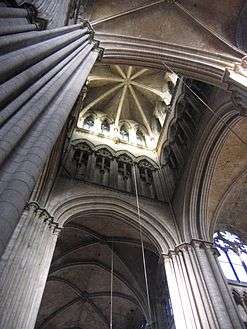Crossing (architecture)

A crossing, in ecclesiastical architecture, is the junction of the four arms of a cruciform (cross-shaped) church.
In a typically oriented church (especially of Romanesque and Gothic styles), the crossing gives access to the nave on the west, the transept arms on the north and south, and the choir, as the first part of the chancel, on the east.
The crossing is sometimes surmounted by a tower or dome. A large crossing tower is particularly common on English Gothic cathedrals. With the Renaissance, building a dome above the crossing became popular. Because the crossing is open on four sides, the weight of the tower or dome rests heavily on the corners; a stable construction thus required great skill on the part of the builders. In centuries past, it was not uncommon for overambitious crossing towers to collapse. Sacrist Alan of Walsingham's octagon, built between 1322 and 1328 after the collapse of Ely's nave crossing on 22 February 1322, is the "... greatest individual achievement of architectural genius at Ely Cathedral" according to architectural historian Nikolaus Pevsner.[1]
A tower over the crossing may be called a lantern tower if it has openings through which light from outside can shine down to the crossing.
In Early Medieval churches, the crossing square was often used as a module, or a unit of measurement. The nave and transept would have lengths that were a certain multiple of the length of the crossing square. This was to ensure that the church was properly proportioned.
Gallery
 Crossing and lantern tower, Rouen Cathedral
Crossing and lantern tower, Rouen Cathedral Crossing with dome, Santa Maria del Fiore, Florence
Crossing with dome, Santa Maria del Fiore, Florence Crossing tower, Canterbury Cathedral
Crossing tower, Canterbury Cathedral Flèche above crossing, Notre Dame de Paris
Flèche above crossing, Notre Dame de Paris Crossing tower, Saint-Sernin Basilica
Crossing tower, Saint-Sernin Basilica Plan of the Basilica of St. Sernin, Toulouse, showing enlarged piers to support tower
Plan of the Basilica of St. Sernin, Toulouse, showing enlarged piers to support tower
References
| Wikimedia Commons has media related to Crossing (architecture). |
- ↑ Pevsner, Nikolaus (1977) [1954], The buildings of England: Cambridgeshire (2nd ed.), Penguin books, pp. 340, 355, ISBN 0-14-071010-8